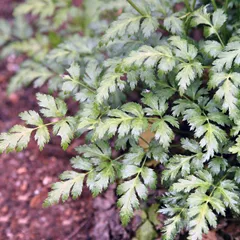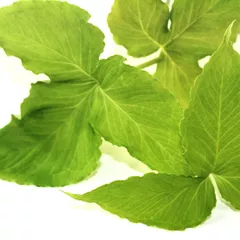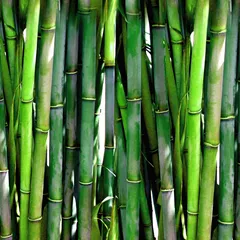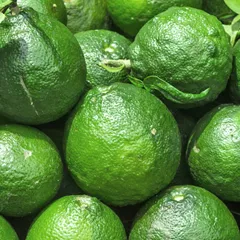Huang Lian
Huang Lian
English: Goldthread rhizomes
Chinese: 黄连
Parts used: Dried rhizome
TCM category: Herbs that clear Heat and dry Dampness
TCM nature: Cold
TCM taste(s): Bitter
Organ affinity: Gallbladder Heart Large intestine Liver Spleen Stomach
Scientific name: Coptis chinensis, Coptis deltoidea or Coptis teeta
Other names: Golden thread, Canker root
Use of Huang Lian (goldthread rhizomes) in TCM
Please note that you should never self-prescribe TCM ingredients. A TCM ingredient is almost never eaten on its own but as part of a formula containing several ingredients that act together. Please consult a professional TCM practitioner, they will be best able to guide you.
Preparation: Remove impurities, soak in water, cut in slices and dry. Crush before use.
Dosage: 1 - 9 grams
Main actions according to TCM*: Expels Damp-Heat especially in the Lower Burner. Eliminates Fire toxicity especially when there is associated Dampness. Acts as a sedative by eliminating Heart Fire. Eliminates Stomach Fire. Expel parasites
Primary conditions or symptoms for which Huang Lian may be prescribed by TCM doctors*: Abdominal bloating Vomiting Acid reflux Fever Bloody sputum Nosebleed Toothache Carbuncles Sores Eczema Conjunctivitis Insomnia Restlessness
Contraindications*: Should not be used by those with Stomach or Spleen Qi Deficiency especially when there is diarrhea. It should also not be used by those with Yin Deficiency, or when there is vomiting or nausea due to Cold.
Common TCM formulas in which Huang Lian is used*
Qing Wei San
Source date: 1336 AD
Number of ingredients: 5 herbs
Formula key actions: Drains Stomach Fire. Cools the Blood. Nourishes the Yin.
Conditions targeted*: StomatitisPeriodontitis and others
Huang Lian is a king ingredient in Qing Wei San. Like the name indicates, it means it has more power than other ingredients in the formula.
In Qing Wei San, Huang Lian attacks the Stomach Fire and drains the accumulation of Heat.
Ban Xia Xie Xin Tang
Source date: 220 AD
Number of ingredients: 7 herbs
Formula key actions: Reverses the flow of Rebellious Stomach Qi. Relieves both Heat and Cold Stagnation in the gastrointestinal tract.
Conditions targeted*: Peptic ulcersGastroesophageal reflux disease and others
Huang Lian is a king ingredient in Ban Xia Xie Xin Tang. Like the name indicates, it means it has more power than other ingredients in the formula.
In Ban Xia Xie Xin Tang, Huang Lian is specific for draining "Stagnation stemming from Dampness and Heat", a key issue this formula aims to treat. It also focuses on the epigastrium, making it an even more specific choice as the key ingredient.
Jiao Tai Wan
Source date: 1522 AD
Number of ingredients: 2 herbs
Formula key actions: Restores the functional communication between the Heart and the Kidneys.
Conditions targeted*: Nervous exhaustionAutonomic dystonia and others
Huang Lian is a king ingredient in Jiao Tai Wan. Like the name indicates, it means it has more power than other ingredients in the formula.
In Jiao Tai Wan, Huang Lian clears pathogenic Heat from the Heart and thereby calms the Mind. By doing so, the ability of the Kidneys to foster a sense of inner rootedness and strength is facilitated so the normal functional relationship between those two Organs is restored. With the anxiety of the Heart and Mind quelled, the Yin is no longer threatened, Kidney Yin is able to ascend and Heart Yin is nourished.
Zuo Jin Wan
Source date: 1481 AD
Number of ingredients: 2 herbs
Formula key actions: Clears Liver Heat. Directs Rebellious Qi downward. Stops vomiting.
Conditions targeted*: EsophagitisGastritis and others
Huang Lian is a king ingredient in Zuo Jin Wan. Like the name indicates, it means it has more power than other ingredients in the formula.
In Zuo Jin Wan, Huang Lian is bitter and cold and it has two functions. The first is to remove Heat from the Heart (Fire), which is the 'child' of the Liver (Wood) in the generative cycle of the Five Phases. When the Heat is drained from the Liver, it no longer rebels horizontally to invade the Stomach.
The second function is to clear Stomach Fire. When the Stomach Fire is drained downward, Qi follows it so that acid reflux is quelled.
Lian Po Yin
Source date: 1862 AD
Number of ingredients: 7 herbs
Formula key actions: Clears Heat. Transforms Dampness. Regulates Qi. Harmonizes the Middle Burner.
Conditions targeted*: GastroenteritisTyphoid and others
Huang Lian is a king ingredient in Lian Po Yin. Like the name indicates, it means it has more power than other ingredients in the formula.
In Lian Po Yin, Huang Lian drains Heat and dries Dampness in the Middle-Burner
Huang Lian E Jiao Tang
Source date: 220 AD
Number of ingredients: 5 herbs
Formula key actions: Enriches the Yin. Causes Fire to descend. Eliminates irritability. Calms the spirit.
Conditions targeted*: Nervous exhaustionAutonomic dystonia and others
Huang Lian is a king ingredient in Huang Lian E Jiao Tang. Like the name indicates, it means it has more power than other ingredients in the formula.
In Huang Lian E Jiao Tang, Huang Lian directly clears Fire from the Heart and thereby calms the Mind
Huang Lian Jie Du Tang
Source date: 752 AD
Number of ingredients: 4 herbs
Formula key actions: Drains Fire. Resolves Toxin.
Conditions targeted*: SepticemiaPyemia and others
Huang Lian is a king ingredient in Huang Lian Jie Du Tang. Like the name indicates, it means it has more power than other ingredients in the formula.
In Huang Lian Jie Du Tang, Huang Lian drains Fire and Heat from the entire body, especially from the Heart and the Middle Burner. Once the fire is effectively cleared, the Toxin will disappear.
Huang Lian Tang
Source date: 220 AD
Number of ingredients: 7 herbs
Formula key actions: Regulates Cold and Heat. Harmonizes the Stomach. Directs Rebellious Qi downward.
Conditions targeted*: GastritisHyperacidic stomach and others
Huang Lian is a king ingredient in Huang Lian Tang. Like the name indicates, it means it has more power than other ingredients in the formula.
In Huang Lian Tang, Huang Lian is bitter and cold. It drains the Excessive Heat from the chest and harmonizes the Stomach.
Huang Lian Jiao Du Tang
Source date: 752 AD
Number of ingredients: 4 herbs
Formula key actions: Drains Fire. Resolves Toxicity.
Conditions targeted*: SepticemiaPyemia and others
Huang Lian is a king ingredient in Huang Lian Jiao Du Tang. Like the name indicates, it means it has more power than other ingredients in the formula.
In Huang Lian Jiao Du Tang, Huang Lian is very useful in draining Fire from the Middle Burner, a region of the body that, if not attended to, can give rise to many complications.
It also drains Fire from the whole body.
Pu Ji Xiao Du Yin
Source date: 1202 AD
Number of ingredients: 14 herbs
Formula key actions: Clears Toxic-Heat. Clears Wind-Heat .
Conditions targeted*: FurunclesCarbuncles and others
Huang Lian is a king ingredient in Pu Ji Xiao Du Yin. Like the name indicates, it means it has more power than other ingredients in the formula.
In Pu Ji Xiao Du Yin, Huang Lian clear and drain the Toxic-Heat from the Upper Burner.
San Zhong Kui Jian Tang
Source date: 1336 AD
Number of ingredients: 17 herbs
Formula key actions: Clears Heat and resolves Toxicity. Reduces swelling. Induces ulceration. Moves the Blood and dispels stasis .
Conditions targeted*: GoiterScrofula and others
Huang Lian is a king ingredient in San Zhong Kui Jian Tang. Like the name indicates, it means it has more power than other ingredients in the formula.
In San Zhong Kui Jian Tang, Huang Lian clears Toxic-Heat. It addresses the accumulated Heat that occurs at the area
of the tumor and also the Heat of specific Organs that are the root cause of the tumor.
Shao Yao Tang
Source date: 1186 AD
Number of ingredients: 9 herbs
Formula key actions: Regulates and harmonizes the Qi and Blood. Clears Heat. Dries dampness. Resolves Toxicity.
Conditions targeted*: Acute enteritisUlcerative colitis and others
Huang Lian is a king ingredient in Shao Yao Tang. Like the name indicates, it means it has more power than other ingredients in the formula.
In Shao Yao Tang, Huang Lian is bitter and very cooling. It resolves Heat toxicity in the Intestines by clearing Heat and drying Dampness.
Wu Shi Lian Mei Tang
Source date: 1798 AD
Number of ingredients: 5 herbs
Formula key actions: Drains Heat. Preserves Body Fluids. Transforms Yin .
Conditions targeted*: Supraventricular tachycardiaDiabetes and others
Huang Lian is a king ingredient in Wu Shi Lian Mei Tang. Like the name indicates, it means it has more power than other ingredients in the formula.
In Wu Shi Lian Mei Tang, Huang Lian is bitter and cold. It enters the Heart to drain pathogenic Summer-Heat, removing the root cause of this pathology.
Combitnation of Chinese plum and Goldthread rhizome is well established in Chinese materia medica. Goldthread rhizome drains the Heat without injuring the normal Qi, while it also prevents the restraining action of Chinese plum from improperly retaining the pathogenic Heat in the body.
Furthermore, the bitterness of Goldthread rhizome, focuses the sourness of Chinese plum on the Yin aspect of the fluids that were damaged within the Lesser Yin.
Niu Huang Qing Xin Wan
Source date: 1568 AD
Number of ingredients: 6 herbs
Formula key actions: Clears Heat and resolves Toxicity. Calms the Mind. Opens up the Orifices.
Conditions targeted*: Viral encephalitisMeningitis and others
Huang Lian is a deputy ingredient in Niu Huang Qing Xin Wan. This means it helps the king ingredient(s) treat the main pattern or it serves to treat a coexisting pattern.
In Niu Huang Qing Xin Wan, Huang Lian , together with Baikal skullcap root (Huang Qin) and Cape jasmine fruit (Zhi Zi), other deputies in this formula, is good at clearing Heat, draining Fire, and resolving toxicity.
They are used here to help the Ox gallstone in clearing Heat from the Heart and resolving toxicity. Indeed, according to authoritative Chinese Medicine literature, Huang Lian "enters the Heart and Pericardium where it is the ultimate at draining fire. It is also able to enter the Liver. While it can guide into both of these Meridians, it is especially entrusted [to guide other herbs] to enter the Heart".
Xiao Xian Xiong Tang
Source date: 220 AD
Number of ingredients: 3 herbs
Formula key actions: Clears Heat. Transforms Phlegm. Expands the chest. Dissipates clumps.
Conditions targeted*: HepatitisCholecystitis and others
Huang Lian is a deputy ingredient in Xiao Xian Xiong Tang. This means it helps the king ingredient(s) treat the main pattern or it serves to treat a coexisting pattern.
In Xiao Xian Xiong Tang, Huang Lian helps Snake gourd (Gua Lou) - the key herb of this formula -drain Heat and turbidity from the Upper and Middle Burners. As often in Chinese medicine it is a mutually beneficial relationship as the moistening nature of Snake Gourd in turn prevents the d of Goldthread rhizome from aggravating the Stagnation.
Xie Xin Tang
Source date: 220 AD
Number of ingredients: 3 herbs
Formula key actions: Drains Fire. Resolves Toxicity. Dries Dampness.
Conditions targeted*: CarbunclesFuruncles and others
Huang Lian is a deputy ingredient in Xie Xin Tang. This means it helps the king ingredient(s) treat the main pattern or it serves to treat a coexisting pattern.
In Xie Xin Tang, Huang Lian ,together with the other deputy herb Baikal skullcap root, drains Heat from the Upper and Middle Burners.
Huang Lian Wen Dan Tang
Source date: 1852 AD
Number of ingredients: 7 herbs
Formula key actions: Clears Hot Phlegm. Clears Gallbladder Heat. Regulates Qi. Harmonizes the Stomach.
Conditions targeted*: HypertensionAngina and others
Huang Lian is a deputy ingredient in Huang Lian Wen Dan Tang. This means it helps the king ingredient(s) treat the main pattern or it serves to treat a coexisting pattern.
In Huang Lian Wen Dan Tang, Huang Lian balances the hot and warm properties of the other ingredients of the formula.
Ge Geng Huang Qin Huang Lian Tang
Source date: 220 AD
Number of ingredients: 4 herbs
Formula key actions: Releases the Exterior. Drains Heat.
Conditions targeted*: Stomach fluAcute enteritis and others
Huang Lian is a deputy ingredient in Ge Geng Huang Qin Huang Lian Tang. This means it helps the king ingredient(s) treat the main pattern or it serves to treat a coexisting pattern.
In Ge Geng Huang Qin Huang Lian Tang, Huang Lian is bitter and it dries Dampness in the Stomach and Intestines so as to stop the diarrhea. It also drains Heat, particularly the Yang brightness-warp Heat.
Wu Mei Wan
Source date: 220 AD
Number of ingredients: 9 herbs
Formula key actions: Warms the Organs. Drains Heat. Calms roundworms. Drains the Liver. Calms the Stomach.
Conditions targeted*: AscariasisBiliary ascariasis and others
Huang Lian is a deputy ingredient in Wu Mei Wan. This means it helps the king ingredient(s) treat the main pattern or it serves to treat a coexisting pattern.
In Wu Mei Wan, Huang Lian makes the worms move downward.
Qing Wen Bai Du Yin
Source date: 1794 AD
Number of ingredients: 14 herbs
Formula key actions: Drains Fire. Resolves Toxicity. Dries Dampness.
Conditions targeted*: MeningitisEncephalitis B and others
Huang Lian is a deputy ingredient in Qing Wen Bai Du Yin. This means it helps the king ingredient(s) treat the main pattern or it serves to treat a coexisting pattern.
In Qing Wen Bai Du Yin, Huang Lian opens the Triple Burner by clearing Toxic-Heat.
Fei Er Wan
Source date: 1156 AD
Number of ingredients: 8 herbs
Formula key actions: Kills parasites. Reduces accumulation. Strengthens the Spleen. Clears Heat.
Conditions targeted*: AscariasisHookworm and others
Huang Lian is a deputy ingredient in Fei Er Wan. This means it helps the king ingredient(s) treat the main pattern or it serves to treat a coexisting pattern.
In Fei Er Wan, Huang Lian clears Heat. It also assists the key ingredients in directing the parasites downward.
The combination of Nutmeg and Goldthread rhizome treats Spleen Deficiency due to accumulation with accompanying Heat.
Dang Gui Liu Huang Tang
Source date: 1336 AD
Number of ingredients: 7 herbs
Formula key actions: Enriches the Yin. Drains Fire. Stabilizes the Exterior. Stops sweating.
Conditions targeted*: TuberculosisDiabetes and others
Huang Lian is a deputy ingredient in Dang Gui Liu Huang Tang. This means it helps the king ingredient(s) treat the main pattern or it serves to treat a coexisting pattern.
In Dang Gui Liu Huang Tang, Huang Lian drains Fire from the Heart.
Pi Pa Qing Fei Yin
Source date: 1665 AD
Number of ingredients: 6 herbs
Formula key actions: Clears Lung Heat . Cools the Blood . Clears Dampness. Invigorates the Blood.
Conditions targeted*: AcneFacial acne and others
Huang Lian is a deputy ingredient in Pi Pa Qing Fei Yin. This means it helps the king ingredient(s) treat the main pattern or it serves to treat a coexisting pattern.
In Pi Pa Qing Fei Yin, Huang Lian clears Heat, drains Dampness and Fire, resolves Tosix-Heat and stops bleeding.
Dang Gui Long Hui Wan
Source date: 1172 AD
Number of ingredients: 11 herbs
Formula key actions: Drains Liver and Gallbladder Fire Excess.
Conditions targeted*: VertigoTinnitus and others
Huang Lian is an assistant ingredient in Dang Gui Long Hui Wan. This means that it either serves to reinforces the effect of other ingredients or it moderates their toxicity.
In Dang Gui Long Hui Wan, Huang Lian drains Fire from the Heart.
Qing Ying Tang
Source date: 1798 AD
Number of ingredients: 9 herbs
Formula key actions: Clears the Nutritive level Heat. Relieves Fire Toxin. Removes Heat. Nourishes Yin.
Conditions targeted*: Encephalitis BMeningitis and others
Huang Lian is an assistant ingredient in Qing Ying Tang. This means that it either serves to reinforces the effect of other ingredients or it moderates their toxicity.
In Qing Ying Tang, Huang Lian is cold and bitter and it clears and removes Heat from the Heart.
Zhi Shi Dao Zhi Wan
Source date: 1247 AD
Number of ingredients: 8 herbs
Formula key actions: Reduces and guides out stagnation and accumulation. Drains heat. Dispels dampness.
Huang Lian is an assistant ingredient in Zhi Shi Dao Zhi Wan. This means that it either serves to reinforces the effect of other ingredients or it moderates their toxicity.
In Zhi Shi Dao Zhi Wan, Huang Lian drains Heat, dries Dampness, and stops dysenteric disorders
Qing Xin Li Ge Tang
Source date: 1602 AD
Number of ingredients: 13 herbs
Formula key actions: Clears Toxic-Heat. Unblocks the stool. Benefits the throat .
Conditions targeted*: TonsillitisPeritonsillar abscess and others
Huang Lian is an assistant ingredient in Qing Xin Li Ge Tang. This means that it either serves to reinforces the effect of other ingredients or it moderates their toxicity.
In Qing Xin Li Ge Tang, Huang Lian clear Toxic-Heat of the Stomach.
Qing Shu Yi Qi Tang
Source date: 1852 AD
Number of ingredients: 10 herbs
Formula key actions: Clears summerheat. Augments the Qi. Nourishes the Yin. Generates Body Fluids.
Conditions targeted*: HyperthermiaHeat stroke and others
Huang Lian is an assistant ingredient in Qing Shu Yi Qi Tang. This means that it either serves to reinforces the effect of other ingredients or it moderates their toxicity.
In Qing Shu Yi Qi Tang, Huang Lian is bitter and cold. It is especially effective in pacifying Fire. Here it is used to assist in clearing Heat and expelling Summer-Heat.
Shi Gao Tang
Source date: 752 AD
Number of ingredients: 7 herbs
Formula key actions: Clears Heat and resolves Toxicity. Releases the Exterior.
Conditions targeted*: TonsilitisPertussis and others
Huang Lian is an assistant ingredient in Shi Gao Tang. This means that it either serves to reinforces the effect of other ingredients or it moderates their toxicity.
In Shi Gao Tang, Huang Lian is bitter and very cold and it excels at draining Heat and resolving Toxicity in the Interior.
Sheng Yang Yi Wei Tang
Source date: 1247 AD
Number of ingredients: 16 herbs
Formula key actions: Strengthens the Spleen. Augments the Qi. Raises the Yang. Releases Dampness.
Conditions targeted*: Atrophic gastritisChronic pelvic inflammatory disease and others
Huang Lian is an assistant ingredient in Sheng Yang Yi Wei Tang. This means that it either serves to reinforces the effect of other ingredients or it moderates their toxicity.
In Sheng Yang Yi Wei Tang, Huang Lian is bitter and strongly cooling in nature. It drains Damp-Heat which causes Qi Stagnation.
With White peony root, it also balances the warming, drying, and dispersing nature of the Wind-dispersing herbs in the formula.
Qing Re Tiao Xue Tang
Source date: 1576 AD
Number of ingredients: 10 herbs
Formula key actions: Expel Dampness. Relieve pain. Move Qi and Blood.
Key TCM concepts behind Huang Lian's properties
In Traditional Chinese Medicine (TCM), Huang Lian belongs to the 'Herbs that clear Heat and dry Dampness' category. Herbs in this category are used to clear inflammatory and infectious conditions, referred to as 'Internal Heat' in TCM. This is why most of the herbs in this category will have both antibacterial and antiviral properties. In TCM one has too much 'Internal Heat' in their body as a result of a deficiency of 'Yin' (which is Cold in nature, see our explanation on Yin and Yang) or, more commonly, an Excess of Yang (Hot in nature). Herbs that clear Heat and dry Dampness treat the latter while, at the same time, relieving the body of excess Dampness. As such they tend to be Cold or Neutral in nature.
As suggested by its category Huang Lian is Cold in nature. This means that Huang Lian typically helps people who have too much 'Heat' in their body. Balance between Yin and Yang is a key health concept in TCM. Those who have too much Heat in their body are said to either have a Yang Excess (because Yang is Hot in nature) or a Yin deficiency (Yin is Cold in Nature). Depending on your condition Huang Lian can help restore a harmonious balance between Yin and Yang.
Huang Lian also tastes Bitter. The so-called 'Five Phases' theory in Chinese Medicine states that the taste of TCM ingredients is a key determinant of their action in the body. Bitter ingredients like Huang Lian tends to have a cleansing action on the body by clearing Heat, drying Dampness and promoting elimination via urination or bowel movements.
The tastes of ingredients in TCM also determine what Organs and Meridians they target. As such Huang Lian is thought to target the Gallbladder, the Heart, the Large intestine, the Liver, the Spleen and the Stomach. Similar to modern medicine, in TCM the Gallbladder stores and releases bile produced by the Liver. It also controls the emotion of decisiveness. In addition to regulating Blood flow, the Heart is believed to be the store of the 'Mind' which basically refers to someone's vitality. The Large Intestine receives the "impure" parts of the digested food from the Small Intestine, absorbs the remaining fluids and excrete the remainder as feces. The Liver is often referred as the body's "general" because it is in charge of regulating the movements of Qi and the Body Fluids. It also takes a leading role in balancing our emotions. The Spleen assists with digestion, Blood coagulation and Fluids metabolism in the body. The Stomach is responsible for receiving and ripening ingested food and fluids. It is also tasked with descending the digested elements downwards to the Small Intestine.
Research on Huang Lian
Qingchang Huashi (a recipe containing Coptidis Rhizoma) was effective and safe in treating active ulcerative colitis patients.1
A study in rats suggested Coptis and berberine (the primary alkaloid in Coptis) are potential agents for preventing intestinal injury.2
Berberine (the primary alkaloid in Coptis) may also have anti-atherosclerosis effects.3
Berberine (the primary alkaloid in Coptis) and basic extracts of Coptis chinensis also have demonstrated positive effects in an animal model of neurodegeneration.4
Animal studies suggest Coptis chinensis rhizomes may help with the pain of irritable bowel syndrome.5
Sources:
1. He HH, Shen H, Zheng K. (2012). Observation of the curative effect of qingchang huashi recipe for treating active ulcerative colitis of inner-accumulation of damp-heat syndrome. Zhongguo Zhong Xi Yi Jie He Za Zhi. , 32(12):1598-601.
2. Zhang, Q; Piao, XL; Piao, XS; Lu, T; Wang, D; Kim, SW (2011). "Preventive effect of Coptis chinensis and berberine on intestinal injury in rats challenged with lipopolysaccharides". Food and chemical toxicology. 49 (1): 61–9. doi:10.1016/j.fct.2010.09.032.
3. Wu, M; Wang, J; Liu, LT (2010). "Advance of studies on anti-atherosclerosis mechanism of berberine". Chinese journal of integrative medicine. 16 (2): 188–92. doi:10.1007/s11655-010-0188-7.
4. Zhang, J; Yang, JQ; He, BC; Zhou, QX; Yu, HR; Tang, Y; Liu, BZ (2009). "Berberine and total base from rhizoma coptis chinensis attenuate brain injury in an aluminum-induced rat model of neurodegenerative disease". Saudi medical journal. 30 (6): 760–6. PMID 19526156.
5. Tjong, Y; Ip, S; Lao, L; Fong, HH; Sung, JJ; Berman, B; Che, C (2011). "Analgesic effect of Coptis chinensis rhizomes (Coptidis Rhizoma) extract on rat model of irritable bowel syndrome". Journal of Ethnopharmacology. 135 (3): 754–61. doi:10.1016/j.jep.2011.04.007.



















































